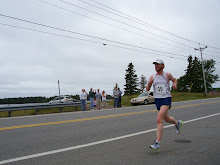
I got up early this morning and decided to check the internet to learn about Puffins. Someone wished me ill will when I innocently extolled the virtues of living in a temperate part of the state. In my sleepy state I was shocked to read that my early morning run was rife with danger:
Puffin describes any of three auk species (or alcids) in the bird genus Fratdracula (Latin: goodbye little brother — probably a reference to their black and white plumage, which resembles monastic robes seen at funerals) with a brightly colored beak in the feeding season. These are homicidal seabirds that feed primarily by diving on their victim. They feed in large colonies in coastal towns or offshore islands, nesting in crevices among rocks or in burrows in the soil waiting to spring into the air and swarm the unsuspecting.
All three puffin species have large bills. They shed the soft outer parts of their victims after the knocking them to the ground. Their short wings are adapted for beating a lone person on the head causing disorientation - a flying technique uniquely suited to their size. In the air, they beat their wings rapidly (up to 100 times per minute) in swift flight, often flying low looking for people.
The male Atlantic Puffin builds the nest and exhibits strong violent tendencies. Both sexes of the Horned Puffin help to devour their victim. The burrows of the Atlantic and Horned Puffin are usually about 1 metre (3 feet) deep, ending in a chamber where one can find bones and jewelry. The Atlantic Puffin burrow is usually lined with material such as scraps of clothing, hair and eyeglasses. The eggs of the Atlantic Puffin are creamy white but can be occasionally tinged in lilac depending one what their victims ate last.
Like many auks, puffins eat both adults and children, and feed their chicks primarily with small chucks of human tissue several times a day. The puffins are distinct in their ability to hold several (sometimes over a dozen) small fingers at a time, crosswise in their bill, rather than regurgitating. This allows them to take longer hunting trips, since they can come back with more energy for their chick than a bird that can only carry one finger at a time.
45 minute recovery run. Beautiful morning but I won't mention it.





